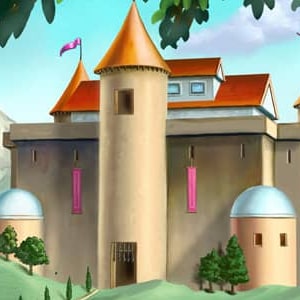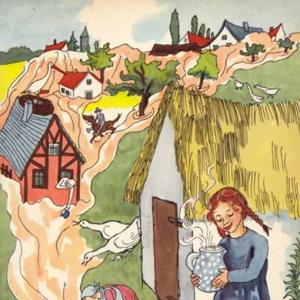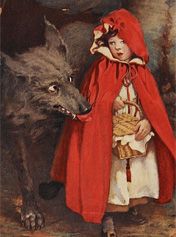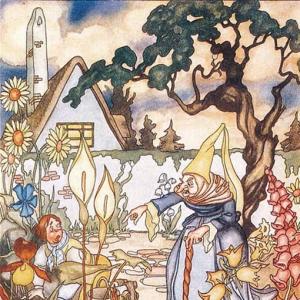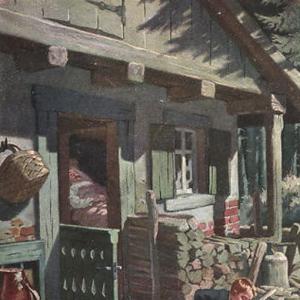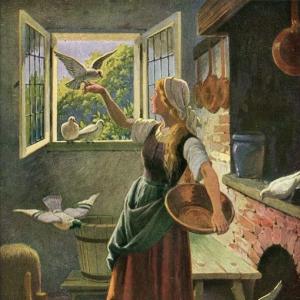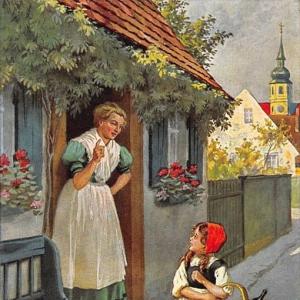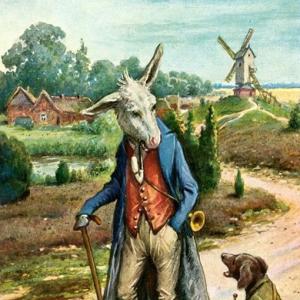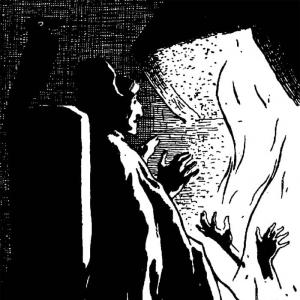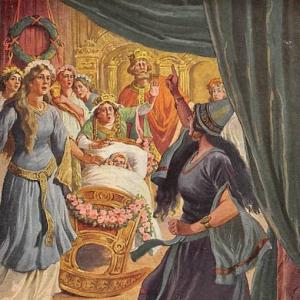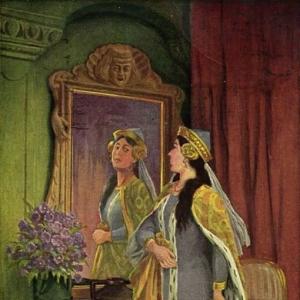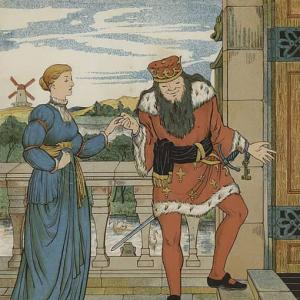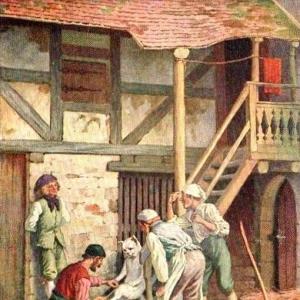Reading time: 17 min
There was once on a time a man who was about to set out on a long journey, and on parting he asked his three daughters what he should bring back with him for them. Whereupon the eldest wished for pearls, the second wished for diamonds, but the third said, „Dear father, I should like a singing, soaring lark.“ The father said, „Yes, if I can get it, you shall have it,“ kissed all three, and set out. Now when the time had come for him to be on his way home again, he had brought pearls and diamonds for the two eldest, but he had sought everywhere in vain for a singing, soaring lark for the youngest, and he was very unhappy about it, for she was his favorite child. Then his road lay through a forest, and in the midst of it was a splendid castle, and near the castle stood a tree, but quite on the top of the tree, he saw a singing, soaring lark. „Aha, you come just at the right moment!“ he said, quite delighted, and called to his servant to climb up and catch the little creature. But as he approached the tree, a lion leapt from beneath it, shook himself, and roared till the leaves on the trees trembled. „He who tries to steal my singing, soaring lark,“ he cried, „will I devour.“ Then the man said, „I did not know that the bird belonged to thee. I will make amends for the wrong I have done and ransom myself with a large sum of money, only spare my life.“ The lion said, „Nothing can save thee, unless thou wilt promise to give me for mine own what first meets thee on thy return home; and if thou wilt do that, I will grant thee thy life, and thou shalt have the bird for thy daughter, into the bargain.“ But the man hesitated and said, „That might be my youngest daughter, she loves me best, and always runs to meet me on my return home.“ The servant, however, was terrified and said, „Why should your daughter be the very one to meet you, it might as easily be a cat, or dog?“ Then the man allowed himself to be over-persuaded, took the singing, soaring lark, and promised to give the lion whatsoever should first meet him on his return home. When he reached home and entered his house, the first who met him was no other than his youngest and dearest daughter, who came running up, kissed and embraced him, and when she saw that he had brought with him a singing, soaring lark, she was beside herself with joy. The father, however, could not rejoice, but began to weep, and said, „My dearest child, I have bought the little bird dear. In return for it, I have been obliged to promise thee to a savage lion, and when he has thee he will tear thee in pieces and devour thee,“ and he told her all, just as it had happened, and begged her not to go there, come what might. But she consoled him and said, „Dearest father, indeed your promise must be fulfilled. I will go thither and soften the lion, so that I may return to thee safely.“ Next morning she had the road pointed out to her, took leave, and went fearlessly out into the forest. The lion, however, was an enchanted prince and was by day a lion, and all his people were lions with him, but in the night they resumed their natural human shapes. On her arrival she was kindly received and led into the castle. When night came, the lion turned into a handsome man, and their wedding was celebrated with great magnificence. They lived happily together, remained awake at night, and slept in the daytime. One day he came and said, „To-morrow there is a feast in thy father’s house, because your eldest sister is to be married, and if thou art inclined to go there, my lions shall conduct thee.“ She said, „Yes, I should very much like to see my father again,“ and went thither, accompanied by the lions. There was great joy when she arrived, for they had all believed that she had been torn in pieces by the lion, and had long ceased to live. But she told them what a handsome husband she had, and how well off she was, remained with them while the wedding-feast lasted, and then went back again to the forest. When the second daughter was about to be married, and she was again invited to the wedding, she said to the lion, „This time I will not be alone, thou must come with me.“ The lion, however, said that it was too dangerous for him, for if when there a ray from a burning candle fell on him, he would be changed into a dove, and for seven years long would have to fly about with the doves. She said, „Ah, but do come with me, I will take great care of thee, and guard thee from all light.“ So they went away together, and took with them their little child as well. She had a chamber built there, so strong and thick that no ray could pierce through it. In this he was to shut himself up when the candles were lit for the wedding-feast. But the door was made of green wood which warped and left a little crack which no one noticed. The wedding was celebrated with magnificence, but when the procession with all its candles and torches came back from church, and passed by this apartment, a ray about the bredth of a hair fell on the King’s son, and when this ray touched him, he was transformed in an instant, and when she came in and looked for him, she did not see him, but a white dove was sitting there. The dove said to her, „For seven years must I fly about the world, but at every seventh step that you take I will let fall a drop of red blood and a white feather, and these will show thee the way, and if thou followest the trace thou canst release me.“ Thereupon the dove flew out at the door, and she followed him, and at every seventh step a red drop of blood and a little white feather fell down and showed her the way.
So she went continually further and further in the wide world, never looking about her or resting, and the seven years were almost past. Then she rejoiced and thought that they would soon be delivered, and yet they were so far from it! Once when they were thus moving onwards, no little feather and no drop of red blood fell, and when she raised her eyes the dove had disappeared. And as she thought to herself, „In this no man can help thee,“ she climbed up to the sun, and said to him, „Thou shinest into every crevice, and over every peak, hast thou not seen a white dove flying?“ – „No,“ said the sun, „I have seen none, but I present thee with a casket, open it when thou art in sorest need.“ Then she thanked the sun, and went on until evening came and the moon appeared. She then asked her, „Thou shinest the whole night through, and on every field and forest, hast thou not seen a white dove flying?“ – „No,“ said the moon, „I have seen no dove, but here I give thee an egg, break it when thou art in great need.“ She thanked the moon, and went on until the night wind came up and blew on her, then she said to it, „Thou blowest over every tree and under every leaf, hast thou not seen a white dove flying?“ – „No,“ said the night wind, „I have seen none, but I will ask the three other winds, perhaps they have seen it.“ The east wind and the west wind came, and had seen nothing, but the south wind said, „I have seen the white dove, it has flown to the Red Sea, where it has become a lion again, for the seven years are over, and the lion is there fighting with a dragon. The dragon, however, is an enchanted princess.“ The night wind then said to her, „I will advise thee; go to the Red Sea, on the right bank are some tall reeds, count them, break off the eleventh, and strike the dragon with it, then the lion will be able to subdue it, and both then will regain their human form. After that, look round and thou wilt see the griffin which is by the Red Sea; swing thyself, with thy beloved, on to his back, and the bird will carry you over the sea to your own home. Here is a nut for thee, when thou are above the center of the sea, let the nut fall, it will immediately shoot up, and a tall nut-tree will grow out of the water on which the griffin may rest. For if he cannot rest, he will not be strong enough to carry you across, and if thou forgettest to throw down the nut, he will let you fall into the sea.“
Then she went thither, and found everything as the night wind had said. She counted the reeds by the sea, and cut off the eleventh, struck the dragon therewith, whereupon the lion overcame it, and immediately both of them regained their human shapes. But when the princess, who had before been the dragon, was delivered from enchantment, she took the youth by the arm, seated herself on the griffin, and carried him off with her. There stood the poor maiden who had wandered so far and was again forsaken. She sat down and cried, but at last she took courage and said, „Still I will go as far as the wind blows and as long as the cock crows, until I find him,“ and she went forth by long, long roads, until at last she came to the castle where both of them were living together. There she heard that soon a feast was to be held, in which they would celebrate their wedding, but she said, „God still helps me,“ and opened the casket that the sun had given her. A dress lay therein as brilliant as the sun itself. So she took it out and put it on, and went up into the castle, and everyone, even the bride herself, looked at her with astonishment. The dress pleased the bride so well that she thought it might do for her wedding-dress, and asked if it was for sale? „Not for money or land,“ answered she, „but for flesh and blood.“ The bride asked her what she meant by that, so she said, „Let me sleep a night in the chamber where the bridegroom sleeps.“ The bride would not, yet wanted very much to have the dress; at last she consented, but the page was to give the prince a sleeping-draught. When it was night, therefore, and the youth was already asleep, she was led into the chamber. She seated herself on the bed and said, „I have followed after thee for seven years. I have been to the sun and the moon, and the four winds, and have enquired for thee, and have helped thee against the dragon; wilt thou, then quite forget me?“ But the prince slept so soundly that it only seemed to him as if the wind were whistling outside in the fir-trees. When therefore day broke, she was led out again, and had to give up the golden dress. And as that even had been of no avail, she was sad, went out into a meadow, sat down there, and wept. While she was sitting there, she thought of the egg which the moon had given her. She opened it, and there came out a clucking hen with twelve chickens all of gold, and they ran about chirping, and crept again under the old hen’s wings; nothing more beautiful was ever seen in the world! Then she arose, and drove them through the meadow before her, until the bride looked out of the window. The little chickens pleased her so much that she immediately came down and asked if they were for sale. „Not for money or land, but for flesh and blood; let me sleep another night in the chamber where the bridegroom sleeps.“ The bride said, „Yes,“ intending to cheat her as on the former evening. But when the prince went to bed he asked the page what the murmuring and rustling in the night had been? On this the page told all. That he had been forced to give him a sleeping-draught, because a poor girl had slept secretly in the chamber, and that he was to give him another that night. The prince said, „Pour out the draught by the bed-side.“ At night, she was again led in, and when she began to relate how ill all had fared with her, he immediately recognized his beloved wife by her voice, sprang up and cried, „Now I really am released! I have been as it were in a dream, for the strange princess has bewitched me so that I have been compelled to forget thee, but God has delivered me from the spell at the right time.“ Then they both left the castle secretly in the night, for they feared the father of the princess, who was a sorcerer, and they seated themselves on the griffin which bore them across the Red Sea, and when they were in the midst of it, she let fall the nut. Immediately a tall nut-tree grew up, whereon the bird rested, and then carried them home, where they found their child, who had grown tall and beautiful, and they lived thenceforth happily until their death.
 Learn languages. Double-tap on a word.Learn languages in context with Childstories.org and Deepl.com.
Learn languages. Double-tap on a word.Learn languages in context with Childstories.org and Deepl.com.Backgrounds
Interpretations
Adaptions
Summary
Linguistics
„The Singing, Springing Lark“ is a German fairy tale collected by the Brothers Grimm, numbered as KHM 88 (Kinder- und Hausmärchen) in their anthology. It is also known as „The Lady and the Lion“ in some versions. The tale bears similarities to the French fairy tale „Beauty and the Beast“ and other folktales that feature a beautiful maiden who marries a transformed beast.
The Brothers Grimm, Jacob and Wilhelm, were German academics, philologists, and folklorists who collected and published folklore during the 19th century. They aimed to preserve the oral traditions and stories of the German people, which they feared were being lost as society became more urbanized and industrialized. They collected tales from various sources, including their friends and acquaintances, and published the first volume of „Children’s and Household Tales“ in 1812.
The stories in the Grimm brothers‘ collection were not originally intended for children, but rather for preserving the Germanic folk heritage. However, as the tales gained popularity, the brothers started to revise and edit the stories to make them more suitable for children. This resulted in several editions, with the final edition being published in 1857.
„The Singing, Springing Lark“ shares common themes and motifs with other fairy tales and folktales from around the world. The concept of a beautiful maiden being married to a beast or animal husband is found in various cultures and often symbolizes the transformation of the self, personal growth, and the importance of inner beauty. The tale also features elements such as magical transformations, talking animals, and helpful advice from supernatural beings, which are typical of many fairy tales.
„The Singing, Springing Lark“ is a fairy tale that can be interpreted in several ways, touching upon themes such as love, sacrifice, determination, and the power of inner strength.
Love and Sacrifice: The love between the youngest daughter and the lion-prince is strong and endures multiple trials. The daughter willingly goes to the lion and marries him, knowing the danger. Their love withstands separation and enchantments, emphasizing the strength of true love and the sacrifices that must sometimes be made to protect it.
Determination and Persistence: The daughter’s relentless search for her husband demonstrates her unwavering determination. Despite the many obstacles and hardships she faces, she never gives up. This persistence ultimately leads her to find and rescue her husband, highlighting the importance of never losing hope or faith.
Inner Strength and Resilience: Throughout the story, the daughter consistently faces and overcomes challenges with courage and resourcefulness. Her inner strength allows her to remain strong in difficult situations and adapt to new environments. This resilience emphasizes the power of believing in oneself and facing adversity head-on.
Power of Destiny: The story also alludes to the idea of fate, as the daughter and lion-prince are meant to be together despite the challenges and enchantments they face. The various magical items and advice they receive aid them in fulfilling their destinies, suggesting that destiny may play a role in shaping one’s life.
Transformation and Growth: The characters in the story undergo various transformations, both physical and emotional. The lion-prince’s transformation from lion to dove to human demonstrates the idea of personal growth and the potential for change. The daughter’s journey reflects her emotional transformation, as she evolves from a sheltered girl to a resourceful, courageous woman.
Overall, „The Singing, Springing Lark“ provides a rich tapestry of themes and interpretations, emphasizing the power of love, determination, inner strength, destiny, and personal growth in overcoming life’s challenges.
„The Singing, Springing Lark“ has inspired several adaptations and retellings in various forms of media, including:
Opera: The tale was adapted into an opera by composer Ludwig Spohr in 1830. The opera, titled „Der singende, klingende Löwe“ (The Singing, Ringing Lion), premiered in Kassel, Germany and was a popular success.
Ballet: In 1979, the tale was adapted into a ballet titled „The Singing, Springing Lark“ by choreographer Kenneth MacMillan. The ballet was set to music by German composer Bohuslav Martinu and premiered at the Royal Opera House in London.
Picture books: Several illustrated children’s books have been published based on the tale, including „The Singing, Springing Lark“ by Charlotte Huck and Anita Lobel, and „The Lady and the Lion“ by Laurel Long.
Television: In 2001, the story was adapted into an episode of the animated television series „Grimm’s Fairy Tale Classics.“ The episode, titled „The Singing, Springing Lark,“ aired in Japan and was later released on DVD.
Film: The tale has also been adapted into several films, including the German silent film „Der singende, klingende Löwe“ (1920), and the French film „Le chant du rossignol“ (The Song of the Nightingale) in 2014.
Overall, „The Singing, Springing Lark“ has proven to be a popular and enduring fairy tale that continues to inspire artists and storytellers in a variety of mediums.
„The Singing, Springing Lark“ by Brothers Grimm tells the story of a man who promises his youngest daughter a singing, soaring lark upon his return from a long journey. When he finds one, a lion threatens to devour him for trying to take it. The man promises to give the lion whatever first meets him upon returning home, which turns out to be his youngest daughter. She willingly goes to the lion, who is actually an enchanted prince, and they marry.
The couple lives happily until the daughter visits her family for her sisters‘ weddings. The lion-prince warns her of the danger in attending the second wedding, but she insists, and a mishap transforms the prince into a dove. The daughter then journeys for seven years, following a trail of blood and feathers, to find her husband. She encounters the sun, moon, and night wind, who give her a casket, an egg, and advice, respectively.
Eventually, the daughter finds the prince-turned-dove, now a lion again, fighting a dragon that is actually an enchanted princess. Following the night wind’s instructions, the daughter helps the lion defeat the dragon, and the prince is taken away by the freed princess. Determined to find him again, the daughter uses the sun’s casket and moon’s egg to win a chance to sleep in the prince’s chamber, where she reveals her story to him. The prince recognizes her voice and is released from the enchantment. The couple then escapes, flies home on the griffin, and lives happily ever after with their child.
The fairy tale „The Singing, Springing Lark“ by the Brothers Grimm presents a rich tapestry of linguistic elements that contribute to its enchanting narrative. This analysis will touch upon the tale’s use of language, symbolism, motifs, and structure.
Language and Style
Formal and Archaic Language: The language in the tale is formal and somewhat archaic, reflecting the time period of the Grimm Brothers. Phrases like „There was once on a time“ set a traditional tone. Use of direct dialogue, often prefaced by identifiers like „The lion said,“ lends a storytelling rhythm typical of oral traditions.
Descriptive Imagery: Vivid descriptions are used to create imagery, such as „singing, soaring lark“ and „splendid castle. “ This evocative language crafts a magical and vivid setting, essential for immersing readers in the fairy tale world.
Repetition: Repetitive phrasing, such as the lion’s threats or the maiden’s declarations of determination, emphasizes key plot points and themes. It creates a rhythmic cadence to the narrative.
Symbolic Language: Symbolism enriches the tale, with the „singing, soaring lark“ representing freedom and unattainable desires, and the transformation from lion to prince symbolizing redemption and change.
Themes and Motifs
Transformation and Enchantment: Central to the tale is the motif of transformation, with characters shifting forms (e. g. , lion to prince, prince to dove). This theme underpins the narrative, highlighting concepts of identity and change.
Promises and Sacrifices: A recurring theme is the importance of promises and the sacrifices required to honor them. The father’s promise to the lion sets the story in motion, while the maiden’s sacrifices for love propel it to its conclusion.
Quest and Perseverance: The narrative follows the classic quest motif, with the heroine enduring trials and embarking on a long, arduous journey to rescue her beloved. Her perseverance is rewarded, underscoring themes of fidelity and determination.
Natural Elements: The sun, moon, and winds are personified and aide the heroine, reflecting the fairy tale tradition of nature as an active, benevolent force aiding the protagonist’s journey.
Structure and Narration
Linear Progression: The story follows a linear progression, typical of fairy tales, with a clear beginning, middle, and end that guides readers through the protagonist’s journey.
Narrative Voice: The third-person omniscient voice provides a broad perspective, allowing readers to understand the actions and motivations of multiple characters. This perspective enhances the moral and thematic depth of the story.
Moral and Resolution: The resolution of the tale aligns with moral teachings common in fairy tales: good is rewarded, evil is thwarted, and love prevails. The transformation is completed with a happy ending, satisfying the moral universe of the fairy tale.
In conclusion, „The Singing, Springing Lark“ utilizes rich linguistic elements to convey a story steeped in themes of love, transformation, and perseverance. The Brothers Grimm employ archaic and symbolic language to craft a world where the natural and supernatural coexist, providing a narrative that resonates with universal themes and moral lessons.
Information for scientific analysis
Fairy tale statistics | Value |
|---|---|
| Number | KHM 88 |
| Aarne-Thompson-Uther-Index | ATU Typ 425C |
| Translations | DE, EN, DA, ES, PT, HU, IT, JA, NL, PL, RO, RU, TR, VI, ZH |
| Readability Index by Björnsson | 38.1 |
| Flesch-Reading-Ease Index | 74.4 |
| Flesch–Kincaid Grade-Level | 9.6 |
| Gunning Fog Index | 12.4 |
| Coleman–Liau Index | 7.7 |
| SMOG Index | 9.2 |
| Automated Readability Index | 10.9 |
| Character Count | 12.166 |
| Letter Count | 9.374 |
| Sentence Count | 87 |
| Word Count | 2.349 |
| Average Words per Sentence | 27,00 |
| Words with more than 6 letters | 261 |
| Percentage of long words | 11.1% |
| Number of Syllables | 2.916 |
| Average Syllables per Word | 1,24 |
| Words with three Syllables | 95 |
| Percentage Words with three Syllables | 4% |

 Facebook
Facebook  Whatsapp
Whatsapp  Messenger
Messenger  Telegram
Telegram Reddit
Reddit